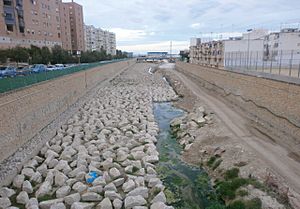Rambla de las Ovejas facts for kids
The Rambla de las Ovejas is a special kind of waterway in the province of Alicante, Spain. Its name means "Ravine of the Sheeps." This water course is often dry, but it can fill up quickly with water during heavy rains.
Contents
What is the Rambla de las Ovejas?
The Rambla de las Ovejas is a natural channel that carries water, especially after it rains a lot. It's like a temporary river that helps drain water from the land.
Where Does it Start and End?
This water course begins high up in the mountains, at the foot of the Maigmo mountain. It starts at about 1,100 meters (around 3,600 feet) above sea level. As it flows, it collects water from the sides of the Maigmo, Cid, and other smaller mountains. It gathers this water through many smaller channels called tributary ravines. The Rambla de las Ovejas finally ends in the city of Alicante. Its mouth is located between the neighborhoods of Babylon and Saint Gabriel.
What Are Its Tributaries?
A tributary is a smaller stream or river that flows into a larger one. For the Rambla de las Ovejas, some of the most important tributary ravines include Rambuchar, Pepior, Alabaster, and Bramble. These smaller channels help bring water from a wide area into the main Rambla.
Floods and Flood Control
Even though the Rambla de las Ovejas is usually dry, it can become a powerful, fast-flowing river during heavy storms. This is because it collects water from a large area very quickly.
The Power of Water: Past Floods
The normally dry riverbed of the Rambla de las Ovejas can experience very strong floods. For example, during heavy rains in 1982, the water flow in Alicante reached an amazing 400 cubic meters per second. That's like 400 large boxes of water flowing by every second! This powerful flood caused a lot of damage to buildings and property, and it was very dangerous for people. In 1997, another flood occurred, with water flowing at 100 cubic meters per second.
Making it Safer: Canalization
Because of the serious floods in the past, the Rambla de las Ovejas has been "canalized." This means that its riverbed has been specially built and shaped to control the water flow better. This work has given the riverbed a much greater capacity, allowing it to handle up to 735 cubic meters of water per second. This helps to protect the city of Alicante and its residents from future floods.


